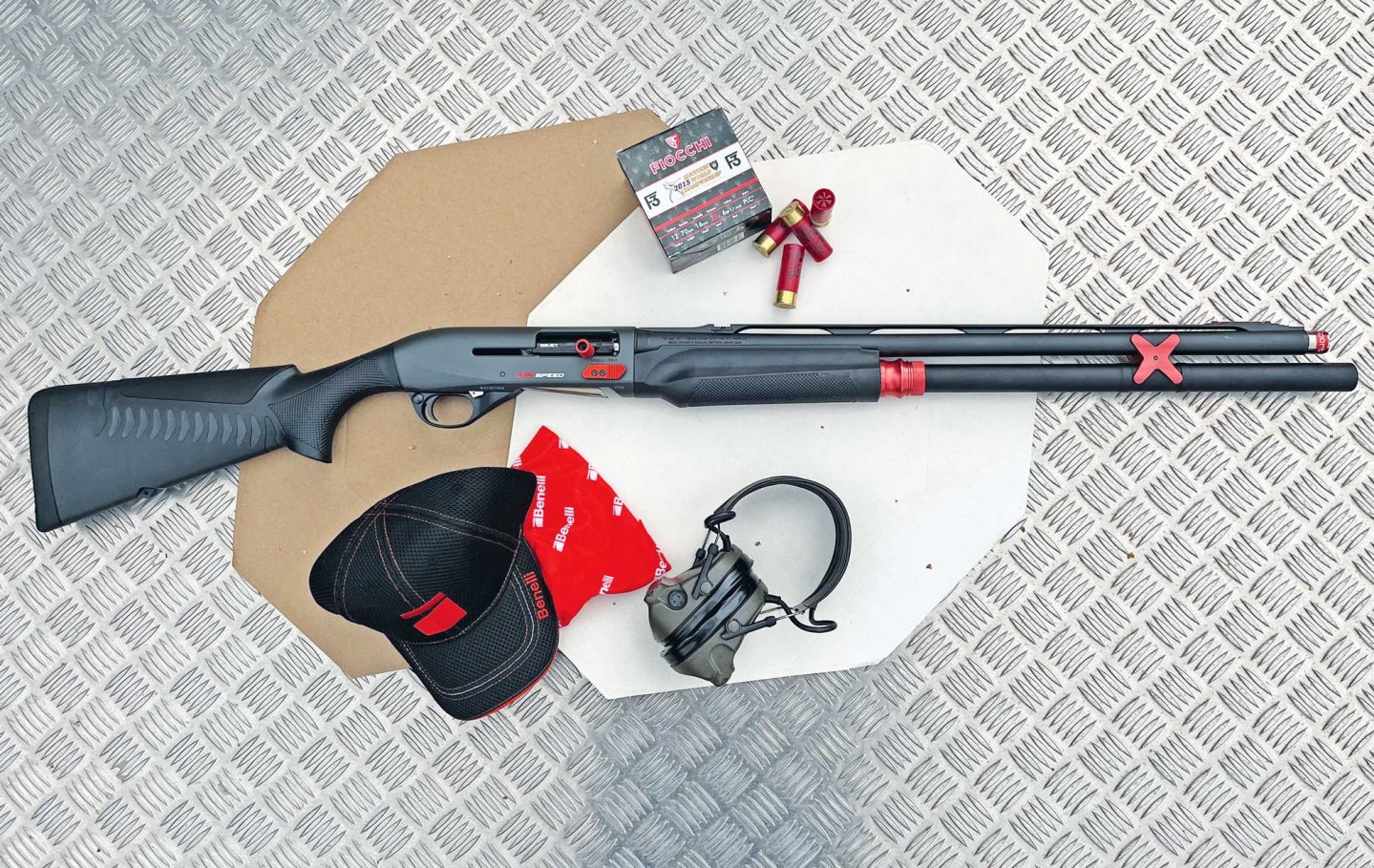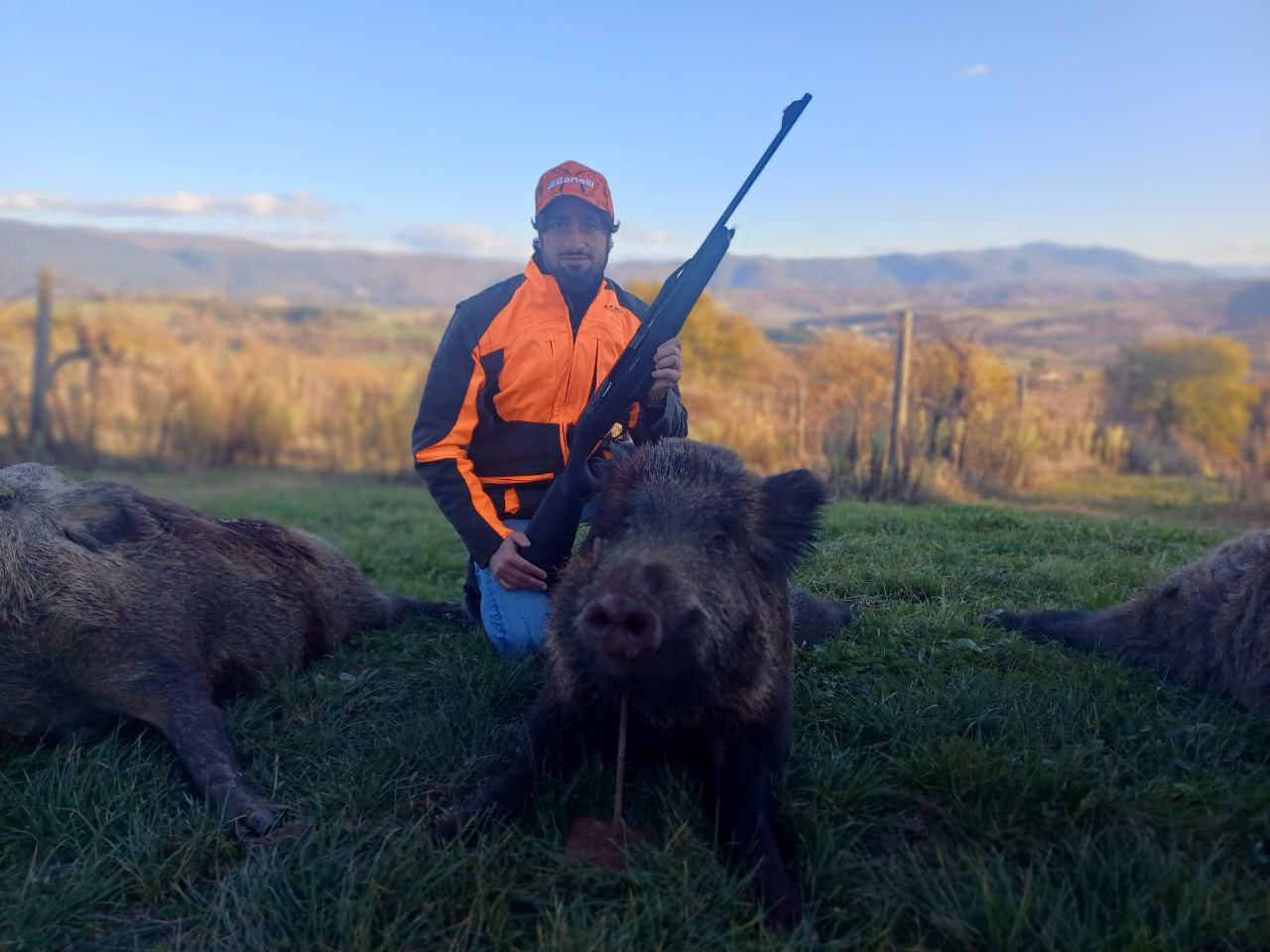We could hardly wait and were looking forward like children to a grab bag when the red and white package with the Benelli lettering on it was brought by the mailman. Inside the box was the new Benelli M2 Speed in 12/76 with a 24" (61 cm) barrel – an optional 26" (66 cm) version is also available. The Italian shotgun manufacturer from Urbino, renowned among law enforcement officers and sport shooters worldwide for its extremely reliable semi-automatic shotguns of the Benelli M2, M3 and M4 series, has packed many goodies into the scope of delivery, so that in addition to the partially disassembled M2 Speed with an already mounted ¼-choke, in the box you will discover for example four additional choke inserts.
The Benelli M2 Speed uses the proven Inertia-Driven system
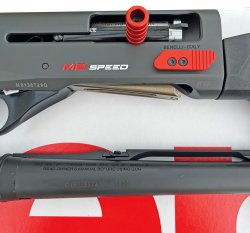
Of course, the 3.3 kg sporting shotgun with light alloy receiver is based on the proven Benelli "Inertia Driven" (ID) operating system. It consists of a two-piece bolt with a strong internal spring. When the gun fires it recoils, the bolt initially stays put because of the inertia principle and locks the action, compressing the inertia spring. When the backward movement of the gun slows down, the spring, which is now released, pushes the bolt body back and ejects the case out.
The recoil spring positioned in the buttstock then pushes the bolt forward again and another cartridge is fed from the tubular magazine into the chamber via the shell lifter. The bolt locks again and the shotgun is ready for the next shot. This self-loading system is more reliable in operation even under extreme environmental conditions and fouls up less than a gas-operated system, which becomes increasingly susceptible to malfunctions after intensive shot strings without intermediate cleaning. On the other hand, a gas-operated shotgun can be tamer in recoil behavior than a smoothbore with a inertia-driven system.
Benelli M2 Speed in 12/76: technical details
The assembly of the partially assembled Benelli M2 Speed is a piece of cake and is also explained in detail in the instruction manual in words and pictures, so we will not go into it further here. The capacity of the long tubular magazine is 10+1 cartridges in 12/76. We shortened the overlong magazine spring to a functional size. This was done for the benefit of easier, faster loading because the pressure of the spring is significantly reduced. This meant that less force was needed to push the cartridges into the magazine. In our case, the spring protruded a whopping 50 cm out of the mounted tubular magazine and was shortened to 30 cm with a side cutter. If you just want to be on the safe side, shorten the spring to 25 cm. But please do not shorten the spring too much, otherwise malfunctions may occur.

The stock and forend are made of a very durable black technopolymer. The buttstock with a factory LOP (Length of Pull, distance between the butt plate and trigger) of 365 mm can be adjusted in length after removing the butt plate with three shims included in the scope of delivery. In addition, two stock mounting plates with differently positioned holes are included with the shotgun. With these parts you can adjust the drop and cast with four different buttstock positions.
The stock must be individually adjusted to the shooter in order not to instinctively miss with the shotgun too low or too high or to the right or left. With the hammer cocked and the safety inserted, the very easy-to-maintain and easy-to-fit trigger group can also be extracted from the receiver by pressing the corresponding stop plug with a little pressure. Removal of the trigger group is easier if the carrier release button is pressed. During reassembly, the the carrier release button must be pressed, otherwise it will stand in the way of the trigger group. We measured the trigger pull weight at 2,750 grams. The bolt is specially coated for best slide properties and fastest bolt cycling. This is complemented by a surface treatment called BE.S.T. (Benelli Surface Treatment) and diamond-like properties for maximum resistance to corrosion, abrasion, wear and external influences. According to the manufacturer, the BE.S.T. uses a highly innovative hybrid technology without any environmentally harmful emissions which, however, falls under the trade secret. Also included in the Benelli M2 Speed package is a choke wrench, which features a thread cleaning tool on the back to remove dirt from the choke thread. If you've ever used your shotgun a lot, or better yet, shot with it a lot, you'll quickly notice that the debris from the powder residues penetrates deep into the threaded area of the choke. A really useful tool for those who not only keep their Benelli in the gun cabinet, but also really use it on the shooting range.
Field test: with the Benelli M2 Speed on the shooting range
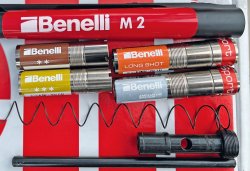
At the first, dry test, the luminous front sight is immediately noticeable. The fiber optic insert works perfectly. We almost had the impression that it was powered by a battery, just like an electronic red dot. Good sights support the shooter, especially with declining visual acuity. For a 25-m accuracy test with slugs, we mounted the ½-choke (three notches), and after a short familiarization period, small groups were quickly achieved at that distance. At 50 meters, the M2 Speed played to its strengths and we were able to shoot an even tighter group with GECO's 12/67.5 Competition Slugs kneeling. Not only in this test, by the way, we did not shoot the shotgun from a rest, but from a kneeling or standing position, as is the case in most shooting sports disciplines. In our opinion, this gives you a better feel for the gun. Certainly there is the possibility of shooting a better group when supported, but for us it is the overall impression that counts. We found the recoil behavior to be very pleasant even when using powerful cartridges, and the padded butt plate did a great job here. Now we had to do the usual test at 100 meters. So far, the shotgun had shot very well in the center. Although with a slightly high shot, which is better than a low shot that is covered by the sight picture or the barrel rib. Since there was still a slight rise at 25 m to 50 m, we aimed first at 100 m. The 30x40 cm steel target immediately acknowledged the hits with a pleasant "pling". The first hits were about 12 to 15 cm low with Brenneke Ruby Sabot ammunition. The energy of the slugs was still so high at 100 m that nothing remained of the structure of the bullet body. Now the ½-choke was exchanged for the long shot choke, which has no notches for marking. Also included are a ¼-choke (four notches), a ¾-choke (two notches) and an "ampliator" choke featuring a kind of groove/land profile that leads to a broad, uniform dispersion even at close range.
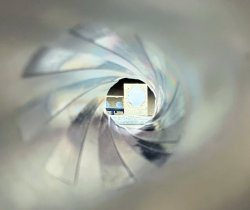
But back to the long shot choke: in IPSC/action disciplines, "no-shoot" steels and poppers often stand side by side, and with such a tight pattern, targets can be engaged cleanly without incurring unpleasant penalty points. We immediately tried engaging five drop plates with this choke. We also tested the modified receiver with an enlarged loading port on the underside. The thumb literally glides in the direction of the tubular magazine and can reliably snap the cartridges into the magazine. The cartridge follower protrudes slightly from the tubular magazine, and even when working quickly, you can hear the cartridges snapping neatly into the magazine. Another advantage is of course that when the magazine is empty, the red follower immediately signals the loading status to the user. We immediately tried out the preferred IPSC loading method, pulling four cartridges out of the belt clip and feeding them with the right hand into the gun, which was lowered at 45°. But since the magazine was not yet full, the next four cartridges were pulled from another cartridge holder with the left hand and also loaded into the magazine. In this way it was tested how, with the gun held high, the cartridges were transferred into the magazine using the left hand. Again, the port was large enough for the thumb to easily push the cartridges into the magazine.
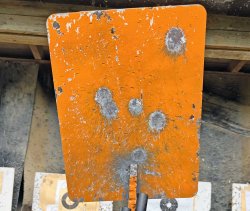
Each cartridge acknowledged its safe position with a click as it snapped into the tubular magazine. After a few rounds, such a four-cartridge load could be accomplished with the gun lowered and the timer signal sounding below three seconds. The trigger was clean and crisp, so shot-to-shot split times of 0.23 to 0.26 seconds were feasible. The shortened spring also worked flawlessly, reliably pushing cartridges out of the tubular magazine and onto the lifter. To test how the tight patterns from the long-shot choke behaved, we mounted an IPSC target in the center of the steel plate rig and shot around the steel plates protruding from the sides from various distances. The tightly concentrated patterns were visible on the freshly painted steel plates, and there were no impacts from individual pellets on the paper target. Finally, a DIN A0 target was mounted on a target carrier and fired at a distance of 10 m using 12/70 cartridges with 2.4-mm buckshot with three of the five chokes provided. Here, the tight group with the long-shot choke, the medium group with the ½-choke, and the broad-dispersing pattern achieved with the "ampliator" choke were very easy to distinguish. Therefore, with the Benelli M2 Speed, you are broadly positioned for every application. With different ammo and different chokes, almost all challenges can be met.
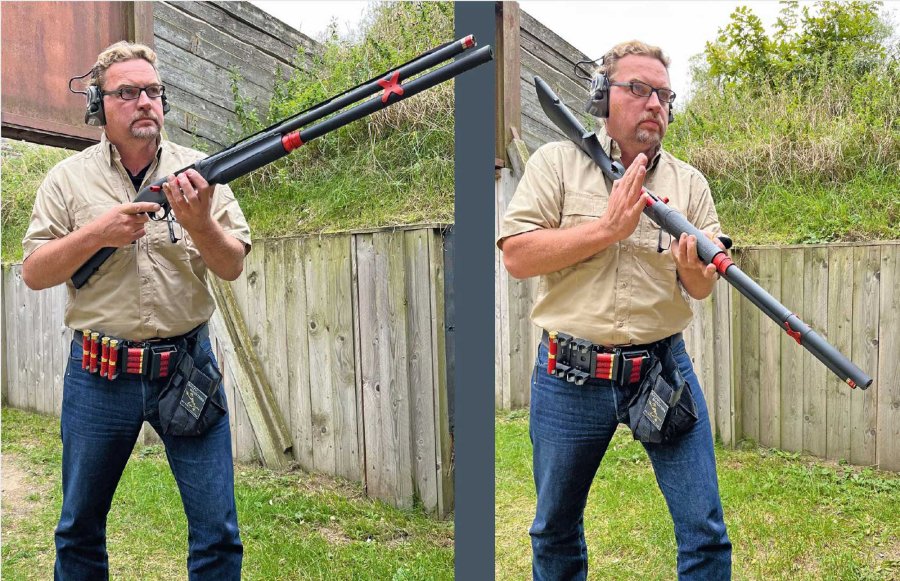
Our test conclusion on the Benelli M2 Speed
The Benelli M2 Speed is a real asset for dynamic, sporting shotgun shooting and you can shoot it right out of the box at a competition. Workmanship, features, function and handling are impressive, especially since the stock can be individually adjusted to the user. The surface finish proved to be abrasion resistant and shone flawlessly after rough practical use and even after more than 350 shots. The price of 2,150 euros is fully adequate in our opinion. Thumbs up!
For more information about the Benelli M2 Speed in 12/76 and other products please visit the Benelli website.


